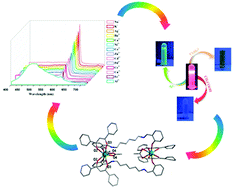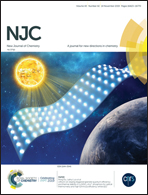Enhanced luminescence for detection of small molecules based on doped lanthanide compounds with a dinuclear double-stranded helicate structure†
Abstract
A novel family of lanthanide materials with a dinuclear double-stranded helicate structure Ln2L2(DBM)4(OAc)2 [Ln = Sm (1), Eu (2) Gd (3) and Yb (4)] constructed from β-diketonate (DBM = dibenzoylmethanide) and an auxiliary ligand Schiff base (H2L = N,N′-bis(salicylidene)butane-1,6-diamine) was investigated. The structures of isostructural complexes 1–4 were determined by single-crystal and powder X-ray crystallography. The optical properties of these compounds could be enhanced by doping, allowing for doped materials with tunable visible and near-infrared emission. Subsequently, a multifunctional sensor was employed to detect CH3COOH, as well as the poisonous ions Al3+ and Cr2O72−. The notable quenching effect and luminescence-based color change showed that doped materials are promising fluorescence probes for the identification and detection of specific anions, cations and organic small molecules.



 Please wait while we load your content...
Please wait while we load your content...